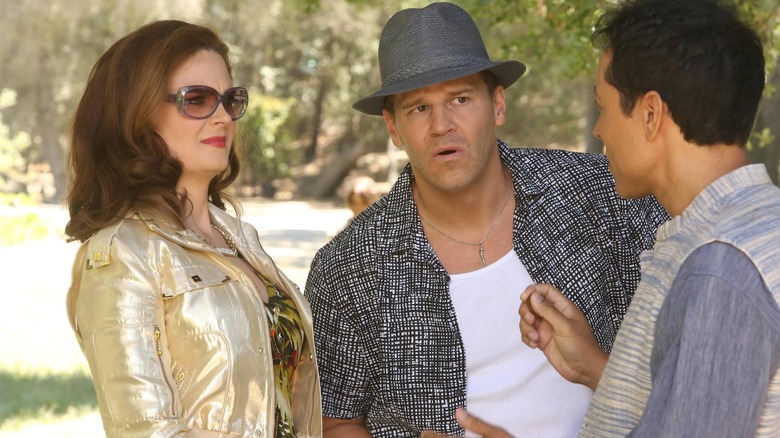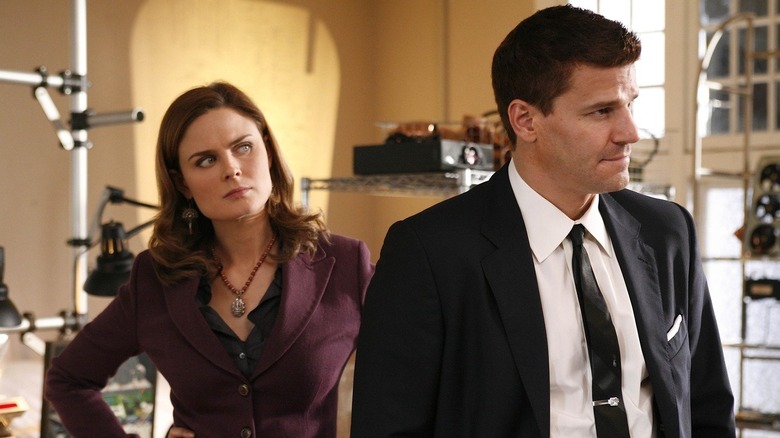These Bones Storylines Were A 'Nightmare' For The Showrunners To Figure Out
Serialized storylines are, naturally, tricky for shows that are, by design, inherently episodic. When "House" devoted a large chunk of its third season to the relentless Detective Michael Tritter (David Morse) trying to get back at Hugh Laurie's misanthropic diagnostician for humiliating him, the series' writers were banking on viewers not losing interest before the pair's conflict had concluded. As one of those viewers, let me tell you: It's a good thing they didn't push their luck any further than they did, even if pitting House against a cop was about as effective a way as any to get us to overlook the former's many, many blatantly unethical indiscretions and root for him to outwit this wannabe Moriarty to his Sherlock.
"Bones," like "House," was primarily episodic, with its namesake, Dr. Temperance Brennan (Emily Deschanel), and her other half, FBI agent Seeley Booth (David Boreanaz), typically wrapping up a murder case within a single hour. But also like "House," it would occasionally devote multiple episodes to a single plotline, usually one that saw the Jeffersonian crew chasing down the same serial killer. This wasn't always for the better and could lead to some patience-testing detours (à la Tritter seeking revenge against House), as well as some downright convoluted narratives like the Gormogon storyline (which even Boreanaz, not mincing words, once flat-out called "just bad television").
Speaking to TV Tango just a few days before season 9 premiered in September 2013, "Bones" creator Hart Hanson admitted those long arcs could be "a nightmare because at our essence we are an episodic show [...] where we solve crime each week." Having to juggle that inevitably made the serialized stories "more difficult," he added, although that also meant that he and his writing staff were "incredibly delighted" when viewers responded well to them.
Bones' episodic murder cases were no cakewalk either
The flip side to this is that Hanson and his "Bones" team had to come up with what they felt were engaging murder mysteries every week. On the one hand, there was less pressure to land a home run; if one of them proved to be a dud, it could be brushed aside and forgotten by the next episode (again, like the medical cases on "House"). The problem is, that also means having to come up with as many as 20-plus interesting murder cases per season, which is no minor feat. As "Bones" writer-producer Stephen Nathan told TV Tango:
"It's much easier on one hand to do a serialized show, because you're just continuing with one story for the characters. To do a case that has to resolve every week is very labor intensive. Fortunately, we have a great writers' room led by Jonathan Collier, and they come up with astounding stories. But after almost 200 episodes, it's very difficult to continue to give the audience murders that are worth [their time]."
The other advantage to episodic arcs is that they can oscillate wildly in tone, swinging from the comedic highs of Bones embarrassing herself on the dance floor or Booth donning a fake mullet to blend in with the crowd at a demolition derby to the somber lows of the show's crime-solvers uncovering a dog-fighting ring or domestic abusers. This, in turn, allows for bigger and bolder swings than you can take with any singular storyline, which generally shouldn't veer too far away from whatever tone is established at the outset.
In the end, that's the thing about serialized plotlines: You better damn well know what you're doing with them on a show like "Bones," lest your audience mutinies against you.

